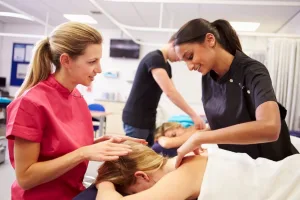By Joan Hannant, Founder & CEO of The Soma Institute
Understanding the differences between hands-on and in-class learning can significantly impact your educational experience and future professional skills when pursuing a career in massage therapy. At The Soma Institute, we believe in offering our students a comprehensive learning journey that blends both approaches, ensuring they are well-prepared for their future careers.
In-Class Learning: Building a Knowledge Base
In-class learning primarily involves theoretical instruction inside a traditional classroom setting. Here, students engage with the foundational knowledge of massage therapy, including anatomy, physiology, pathology, ethics, and business practices. This format allows for extensive discussion, theoretical assessments, and the study of case histories, which are crucial for understanding the science behind massage techniques.
Hands-On Learning: Skill Application
On the other hand, hands-on learning empowers students to apply what they have learned in the classroom to real-life scenarios. This learning takes place in labs, clinics, or through externships, providing students with the opportunity to practice massage techniques under the guidance of experienced instructors. This direct interaction with clients not only helps students refine their skills but also instills a sense of confidence as they learn proper client handling and understand the nuances of administering therapeutic massages.
The Interplay of Both Worlds
Integrating both learning styles enhances a student’s competence and confidence. In-class learning equips students with the necessary theoretical knowledge that forms the backbone of their practice. Meanwhile, hands-on learning offers the practical experience needed to master the art and science of massage therapy. This dual approach ensures that students know the techniques and understand when and how to apply them effectively.
At The Soma Institute, our curriculum is designed to balance these two educational approaches, ensuring our graduates are well-prepared to meet the demands of their future clients and the evolving field of massage therapy.


